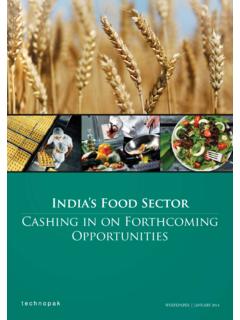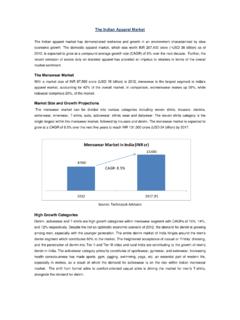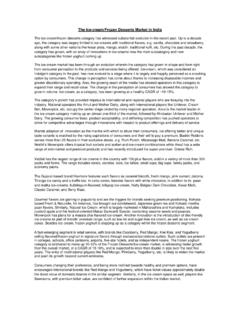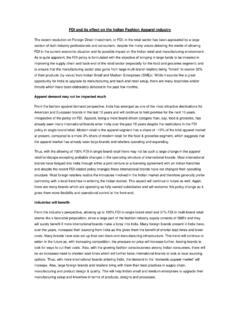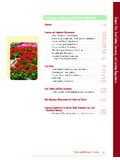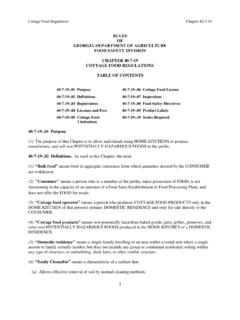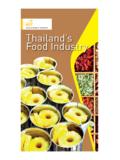Transcription of India Food Services Trends - Technopak
1 IndiaFood the TrendsThe year 2013 has been a mixed bag for food Services operators in India . On the one hand, the entry of several global chains was announced, which indicates a positive outlook within the Indian food Services sector. On the other hand, pressures from both supply and demand sides kept operators on their toes and presented newer year 2014 is likely to be a critical year for the Indian economy. General Elections are scheduled in the second quarter of the year and thus, no major policy changes can be expected in the first half. It can only be hoped that the voters will deliver a clear verdict and that the next government will take urgent and concrete steps towards reviving a sluggish economy and boost market sentiment. We have captured some expected Trends for the year ahead, both on the consumer as well as operator fronts.
2 These cover the aspects of operational efficiency, social marketing, choice of menus and concepts as well as their extensions, as also emerging F&B destinations. The Indian consumer essentially remains diverse in choice and dynamic in nature, demanding newer, better, and more innovative F&B options spanning more variety, delightful taste, superior quality, and better value every day. It is this consumer that drives the growth of the business more than anything else and it is in exceeding the expectations of this vibrant consumer that foodservice operators will find their true Division ServicesBusiness Strategy Opportunity Assessment India Entry Strategy/Market Entry Strategy Competitive Assessment Business Plan Development Business Expansion Plan Supply Chain Assessment Supply Chain Strategy Inventory, Warehouse and Logistics Management Process Re-EngineeringPerformance Audit Revitalize Business Positioning Evaluate Product, Price, Market, and Location Strategy Address Opportunities for Improvements Conduct and Establish Plant Audit ProcessTurnkey Solutions Feasibility Studies.
3 Business Planning Technology/Machinery Selection Product Selection and Development Implementation Support Sector Opportunity Scan Industry/Sector Specific Snapshot Define Processing Mix or Crop Mix Marketing and Procurement Planning Equipment, Machinery and Infrastructure Planning Land Use Planning Develop Detailed Business Plan Implementation Assistance Project Management Consulting Construction Management Support Partner Search Business Strategy for the Local Market Identify and Shortlist Prospective Partner Schedule Meetings Signing of MoU and Partner SelectionSector/Consumer Insights Trends and Consumption Insights Segmentation Studies Product Testing010509 IncreasIng Importanceof sIdes and dessertswIthIn the menu mIxconvenIence food gaInIng share In the menuemergence of new10 f&B destInatIonseffIcIency: a Key factor for growthgrowIng culture of tastIng menu & smaller portIonsunlImIted foodlImIted prIce020610growIng demand for taKeaway and homedelIvery servIcessocIal medIastImulatIng the BrandconnectIndIan cuIsInerevItalIzIng the localdInIng experIenceIncreasIngInfusIon of healthfood03070408 ContentsAuthors:Reetesh Shukla | Associate DirectorRavindra Yadav | Principal ConsultantVidul Sharma | Principal ConsultantDesign & Development:Arvind Sundriyal | Assistant Manager-DesignSonali Rawat Sharma | Graphic DesignerIndia food Services Trends | 20141 Efficiency A Key Factor for Growth2013 has been a tough year for Indian F&B operators.
4 While the entry of global players like Starbucks and Dunkin Donuts was seen as a positive step towards the globalization of the Indian industry, the cost of operations has been posing a continual challenge and operators are having a tough time keeping their necks above water. The past year saw an unprecedented increase in prices of all F&B inputs, with Fruits and Vegetables (F&V) leading the pack throughout the year. The coming year seems to offer no respite, and operators may continue to face twin pressures, from a decline in demand as well as from increasing costs. Efficiency will not only continue to be the buzzword but will, in fact, become a necessity for survival for food service in food PricesWhile the past 5 years saw inflation remaining consistently high, 2013 was exceptionally challenging with prices rising on average over 10%. food inflation stood at in November, 2013 and was the highest contributor to the overall inflation rate ( ).
5 Given that 2014 is an election year, the actual rate of inflation will also be impacted by the mandate delivered by the voters; a fractured one can mean an extended uncertainty over policymaking by the new government. At this juncture, however, going by past Trends , a medium-to-high food inflation rate can be expected in the coming year as Inflation by CommodityExhibit 1 Source: Ministry of Commerce, Technopak Analysis20132012 All CommoditiesPrimary GoodsNon-foodFuel & PowerFoodManufactured Goods05101520 Rate of Inflation (%) India food Services Trends | 20142 Price (per litre) of Diesel in Delhi (INR)Exhibit 3 Source: Secondary ReportsDec 6, 2010 Oct 1, 2011 June 18, 2012 July2, 2009 Feb 27, 2009 Apr 1, 2010 July 25, 2012 Aug 1, 2012 Sept 14, 2012 Oct 27, 2012 Sept 8, 2011 Nov 2, 2011 Jun 25, 2011 July 1, 2011 Apr 1, 2013 May 11, 2013 June 1, 2013 July 1, 2013 Aug 1, 2013 Sept 1, 2013 Oct 1, 2013 Nov 1, 2013 Dec 1, 2013 Dec 21, 2013 Jan 18, 2012 Feb 16, 2012 Mar 23, 2012303540455055 Staff Costs.
6 In view of the persistently high rate of inflation this year, the dearness allowance (which is linked to the Wholesale Price Index (WPI)) was hiked, leading to an increase in the cost of labor and further pressurizing the industry. In the coming year, the average wage increase is anticipated to be ~11%, as a consequence of which it will be increasingly imperative for operators to keep a sharp eye on this cost Costs (HLP): The average increase in energy costs this year was 11%. The price of diesel in Delhi, for instance, increased at a CAGR of 18% from INR (l) in December, 2010, to INR in December, 2013. This has impacted not only the cost of logistics but also the cost of power backup for operators. This trend, of increasing diesel prices, is expected to continue, given the government s stated policy of reducing diesel subsidy in a bid to contain the Current Account Deficit (CAD).
7 Inflation in food Prices, 2013 Exhibit 2 Source: Ministry of Commerce & Industry, Technopak AnalysisRate of Inflation in food Prices (%)5010152025 AprMayJuneJulyAugSeptOctNovIndia food Services Trends | 20143At the same time, the higher cost of diesel has increased input costs at the farm level, leading to a further spike in food prices. Simultaneously, the costs of electricity and cooking gas have also increased, adding to the burden on most food service Costs: Despite a slowdown in 2013, India continues to experience a shortage of quality real estate. Given that location is the most important factor affecting the success of food service operators, the demand for quality locations is always high thereby resulting in a high occupancy costs at good quality locations. For food service operators, rentals can amount to anywhere between 8-25% of their revenues, depending on the format.
8 This is in sharp contrast to operators in developed economies, wherein the typical cost of occupancy is ~15% of revenues. Apart from rental costs, Common Area Maintainance (CAM) charges, levied by mall operators, have also seen a sharp increase in tandem with the rise in such input costs as security, housekeeping, and common area power costs. For most chain operators, expansion is necessary in order to achieve economies of scale and neutralize fixed corporate overheads. Since these operators are seen as bulk consumers of real estate, they are generally able to manage more efficient rental deals, with some of the risk covered via revenue-sharing. While they will continue to drive the demand for real estate, it will create additional pressure on small and non-organized operators due to their weaker negotiating power with Way Ahead2013 saw a further slowdown in GDP growth, leading to a general slowing of demand.
9 Given the uncertainty over employment continuing for most of the year, households cut down on aspirational/non-essential expenses, to get maximum value out of each rupee spent. As a result, the F&B industry, which is already challenged on the cost front, has not been able to pass on the impact of spiraling prices to the consumer, adding to the pressure on bottom lines. The greatest impact is felt by non-organized players who are least insulated against inflation, and by the value-driven chains for whom entry-level pricing is a key demand the coming year, operators will have to walk a tightrope in terms of balancing high input costs while generating additional revenues in an otherwise low-growth economy. They will have to improvise on their sales and marketing strategies to attract consumers and, at the same time, indulge in smart menu engineering, efficient use of real estate, smart hiring and strict F&B controls to cushion the impact of high input costs.
10 The last quarter results of major food service players has actually shown a degrowth, which is a cause of serious concern for food Services Trends | 20144 India food Services Trends | 20145 Unlimited food Limited Price02 Trend Fixed price menus have emerged and evolved within the Indian food Services space in recent years, and especially in the CDR and FDR formats. Their growth can be attributed to the changing lifestyles of the urban population (of which youngsters make up a high proportion), double income households, and single working women with a high propensity to spend. Furthermore, the increased exposure to eating out in the media has helped develop the market by enticing people to try new cuisines, concepts, and recipes, and eat out frequently. This widespread shift in lifestyles has encouraged operators to try formats and concepts that cater to the needs of this growing segment and give them an engaging platform.
